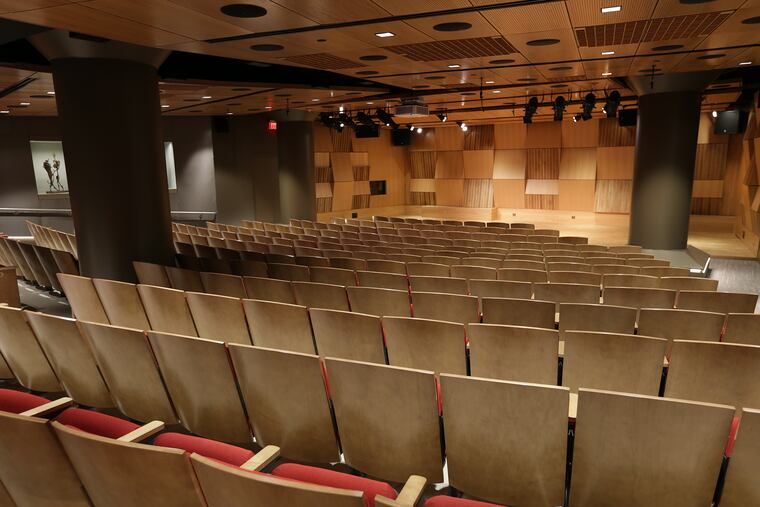New PAFA performance space leaves something to be desired in its first classical outing
In a PCMS concert, the Marinus Ensemble took the new venue's acoustics out for a first spin.

With the recent opening of the Met Philadelphia at Poplar Street and stirrings of a larger presence for the Pennsylvania Ballet near Callowhill, the North Broad Street corridor might finally be realizing some semblance of arts equity with South Broad.
The official unveiling last week of what’s billed as an arts center at the Pennsylvania Academy of the Fine Arts promises added vitality, if not yet critical mass.
The John and Richanda Rhoden Arts Center includes a 270-seat auditorium, a new student gallery, and storage vaults, all in the basement of PAFA’s Hamilton Building.
The size of the auditorium is attractive. With less than half the number of seats as the Kimmel’s Perelman Theater, PAFA’s new performance space fills a niche in the city for any group looking for a cozy, handsome venue.
But acoustics matter, too, and on Sunday afternoon, the Philadelphia Chamber Music Society took it for a first spin. New halls take a while to settle in, and this one, which employs an extensive sound system of speakers both on stage and overhead, seems more complicated than most.
On first hearing, though, it sounded awfully dry.
PCMS brought in the Marinus Ensemble for the occasion, which offered the virtue of variety. The group appeared in various configurations — string quartet with soprano in a delicate novelty by Nino Rota, string quartet and piano for Shostakovich’s prismatic spectrum of moods, and more.
Acoustically, the main sound quality was no-nonsense clarity, though no piece on this hearing suggested the arrival of a first-class concert hall. The Perelman is by no means a resonant hall, but PAFA’s new auditorium is even drier.
The room slopes down to a stage whose walls are made of panels angled like a child’s wood blocks. The ceiling is low and studded with speakers and lights. The unavoidably prominent feature of the hall are three massive support columns; seating is smartly arranged so there are no seats behind the main column in the center of the hall, and the other two frame the stage.
Glassed cases on either side of the hall feature sculptures by John Rhoden. The space is named for the artist and his wife, whose estate granted both artwork and cash to PAFA.
Every group that uses the auditorium will have to “tune” the Yamaha sound system to its liking. But for this performance, PCMS’s visiting artists chose a small amount of amplification. In Turina’s Piano Quartet in A Minor, Op. 67, the setting produced a sound that wasn’t warm, but it perfectly balanced violinist Francesca DePasquale, violist Rachel Kuipers Yonan, cellist Matthew Zalkind, and pianist Young-Ah Tak.
But in Shostakovich’s Piano Quintet in G Minor, Op. 57 (violinist Elizabeth Fayette joined in this and other works), the piano grew harsh in the upper register at the upper levels of dynamics.
It wasn’t the piano itself, which was the same Model D Steinway Concert Grand that PCMS has brought into other recent recitals at the American Philosophical Society. The bald tone might have been a miscalculation on Tak’s part, but I doubt it, because her sound was so fluid and hospitable elsewhere, as in the opening figures of the finale.
The luscious urgency of Chausson’s Chanson perpétuelle, Op. 37, came across nicely, and one stretch, where there was no piano but just string quartet and voice, was especially sweet. Soprano Sarah Shafer more than held her own in the work, though oddly, in Nino Rota’s Il Presepio, for soprano and string quartet, her sound wasn’t up to balance with the others.
One acoustical factor that will be hard to change is the presence of the Broad Street subway just a few feet east from the auditorium. It wasn’t a loud rumble, and in more highly amplified concerts it probably won’t be audible. But in delicate Chausson and parts of the Shostakovich, it was a distraction.
Again, concert halls settle in, and this one more than most deserves repeated listening before any verdicts. On first hearing, though, it appears there is work to do.
The best concert halls do more than report sound to listeners with absolute fidelity. They support the sound and give something back in the way of warmth and resonance. This one, I suspect, is capable of more generosity than was apparent the first time around.